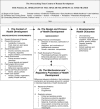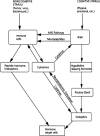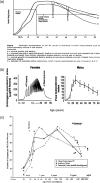Life course health development: an integrated framework for developing health, policy, and research
- PMID: 12233246
- PMCID: PMC2690118
- DOI: 10.1111/1468-0009.00019
Life course health development: an integrated framework for developing health, policy, and research
Abstract
The life course health development (LCHD) framework organizes research from several fields into a conceptual approach explaining how individual and population health develops and how developmental trajectories are determined by interactions between biological and environmental factors during the lifetime. This approach thus provides a construct for interpreting how people's experiences in the early years of life influence later health conditions and functional status. By focusing on the relationship between experiences and the biology of development, the LCHD framework offers a better understanding of how diseases occur. By suggesting new strategies for health measurement, service delivery, and research, as well as for improving health outcomes, this framework also supports health care-purchasing strategies to develop health throughout life and to build human health capital.
Figures





Similar articles
-
Placing Health Trajectories in Family and Historical Context: A Proposed Enrichment of the Life Course Health and Development Model.Matern Child Health J. 2017 Oct;21(10):1853-1860. doi: 10.1007/s10995-017-2354-4. Matern Child Health J. 2017. PMID: 28828547
-
Outcomes evaluation: care continuum alliance research to establish guidance on population health management in provider-driven models.Popul Health Manag. 2012 Jun;15(3):186-7. doi: 10.1089/pop.2012.1531. Popul Health Manag. 2012. PMID: 22731849 No abstract available.
-
Quality of life: a model for evaluating health for all. Conceptual considerations and policy implications.Soz Praventivmed. 1992;37(6):301-6. doi: 10.1007/BF01299136. Soz Praventivmed. 1992. PMID: 1492503
-
An integrative framework for community partnering to translate theory into effective health promotion strategy.Am J Health Promot. 2003 Nov-Dec;18(2):168-76. doi: 10.4278/0890-1171-18.2.168. Am J Health Promot. 2003. PMID: 14621414 Review.
-
Application of health status assessment measures in policy research.Med Care. 1989 Mar;27(3 Suppl):S12-26. doi: 10.1097/00005650-198903001-00002. Med Care. 1989. PMID: 2537920 Review.
Cited by
-
The challenges facing programs for the prevention and control of non-communicable diseases in Iran: a qualitative study of senior managers' viewpoints.BMC Health Serv Res. 2022 Nov 15;22(1):1354. doi: 10.1186/s12913-022-08778-6. BMC Health Serv Res. 2022. PMID: 36380327 Free PMC article.
-
Addressing social determinants of health at well child care visits: a cluster RCT.Pediatrics. 2015 Feb;135(2):e296-304. doi: 10.1542/peds.2014-2888. Epub 2015 Jan 5. Pediatrics. 2015. PMID: 25560448 Free PMC article. Clinical Trial.
-
Maternal pre-pregnancy BMI, gestational weight gain, and age at menarche in daughters.Matern Child Health J. 2013 Oct;17(8):1391-8. doi: 10.1007/s10995-012-1139-z. Matern Child Health J. 2013. PMID: 23054446 Free PMC article.
-
Different setting, different care: integrating prevention and clinical care in school-based health centers.Am J Public Health. 2010 Sep;100(9):1592-6. doi: 10.2105/AJPH.2009.186668. Epub 2010 Jul 15. Am J Public Health. 2010. PMID: 20634447 Free PMC article.
-
Transition from pediatric to adult care in sickle cell disease: establishing evidence-based practice and directions for research.Am J Hematol. 2011 Jan;86(1):116-20. doi: 10.1002/ajh.21880. Am J Hematol. 2011. PMID: 21061308 Free PMC article.
References
-
- Andrews AB, Ben-Arieh A. Measuring and Monitoring Children's Well-Being Across the World. Social Work. 1999;44(2):105–15. - PubMed
-
- Baltes PB, Graf P. Psychological Aspects of Aging: Facts and Frontiers. In: Magnusson D, editor. The Lifespan Development of Individuals: Behavioral, Neurobiological, and Psychosocial Perspectives. Cambridge: Cambridge University Press; 1996. pp. 427–60.
-
- Baltes PB, Lindenberger U, Staudinger UM. Life Span Theory in Development Psychology. In: Lerner RM, Damon W, editors. Handbook of Child Psychology. 5th ed. Vol. 1. New York: Wiley; 1998. pp. 1029–144. Theoretical Models of Human Development.
-
- Barker DJP. Fetal and Infant Origins of Adult Disease. London: Latimer Trend; 1992.
-
- Barker DJP. Mothers, Babies, and Health in Later Life. Edinburgh: Churchill Livingstone; 1998.
Publication types
MeSH terms
Grants and funding
LinkOut - more resources
Full Text Sources

